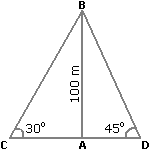Aptitude - Height and Distance - Discussion
Discussion Forum : Height and Distance - General Questions (Q.No. 1)
1.
Two ships are sailing in the sea on the two sides of a lighthouse. The angle of elevation of the top of the lighthouse is observed from the ships are 30° and 45° respectively. If the lighthouse is 100 m high, the distance between the two ships is:
Answer: Option
Explanation:
Let AB be the lighthouse and C and D be the positions of the ships.

Then, AB = 100 m,  ACB = 30° and
ACB = 30° and  ADB = 45°.
ADB = 45°.
| AB | = tan 30° = | 1 |  AC = AB x 3 = 1003 m. AC = AB x 3 = 1003 m. |
| AC | 3 |
| AB | = tan 45° = 1  AD = AB = 100 m. AD = AB = 100 m. |
| AD |
 CD = (AC + AD) CD = (AC + AD) |
= (1003 + 100) m |
| = 100(3 + 1) | |
| = (100 x 2.73) m | |
| = 273 m. |
Discussion:
104 comments Page 5 of 11.
Shro said:
1 decade ago
@Sahil
square root of 3 is 1.73.
So ,add 1.73 + 1 = 2.73
square root of 3 is 1.73.
So ,add 1.73 + 1 = 2.73
Ram said:
1 decade ago
How can you write AD=AB?
Pradeep K Kerketta said:
1 decade ago
How can you manually calculate root 3?
Sumedha said:
1 decade ago
Why we have taken tan and not sin and cos?
Manisha said:
1 decade ago
Why we taken only tan? please explain.
Srinureddy said:
1 decade ago
Hello friends. As best of my knowledge. Here we find the distance between two ships i.e. (AC+AD).
Here we know the height of the lighthouse (AB=100m). For the sake of we taken only (TAN = AB/AC). But not take. Sin&Cos.
Here we know the height of the lighthouse (AB=100m). For the sake of we taken only (TAN = AB/AC). But not take. Sin&Cos.
Prasad said:
1 decade ago
How to solve the problem I am not under standing for Tan value.
Vijeth said:
1 decade ago
Why you multiply 3?
Bhanu said:
1 decade ago
Section A of 5th standard has a class strength of 40 with an average height of 100.5 cm. Section B has a class.
Strength of 50 with an average height of 96 cm. What is the weighted average height of students in the 5th.
Standard? (Rounded to the nearest 0.5 cm).
Strength of 50 with an average height of 96 cm. What is the weighted average height of students in the 5th.
Standard? (Rounded to the nearest 0.5 cm).
Ganesh said:
1 decade ago
Just try to understand.
We need to find AC and we know only AB.
BY P. Theorem, perpendicular/base, i.e.. AB/AC i.e., = tan.
1) We didn't know the value CB, if we take AB/CB no AC omit this.
2) AC/CB both value not known so no chance.
3) There is nothing called AC/AB mean base/perpendicular cancel this.
That's it try to read formula section you will understand.
We need to find AC and we know only AB.
BY P. Theorem, perpendicular/base, i.e.. AB/AC i.e., = tan.
1) We didn't know the value CB, if we take AB/CB no AC omit this.
2) AC/CB both value not known so no chance.
3) There is nothing called AC/AB mean base/perpendicular cancel this.
That's it try to read formula section you will understand.
Post your comments here:
Quick links
Quantitative Aptitude
Verbal (English)
Reasoning
Programming
Interview
Placement Papers